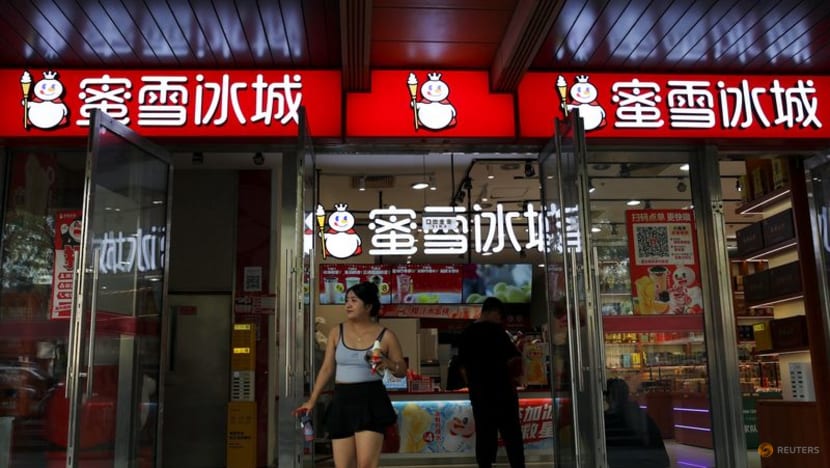Commentary: How Chagee, Mixue and Luckin are brewing success in a crowded market
The Chinese tea and coffee chains offer lessons for consumer brands in a changing business environment, says economist Lee Kok How.
.jpg?itok=OppDU7yc)
Chagee, Mixue and Luckin Coffee stores. (Photos: Facebook/Chagee Singapore, Facebook/Mixue Singapore, Facebook/Luckin Coffee Singapore)

This audio is generated by an AI tool.
SINGAPORE: Chinese beverage companies are having their moment in the spotlight. Chagee CEO Zhang Junjie became a billionaire at age 30 after the tea chain successfully went public on the Nasdaq on Apr 17, against the backdrop of the US-China tariff war.
Just weeks earlier, beverage giant Mixue – now the world’s largest F&B chain by store count, surpassing McDonald’s and Starbucks – listed in Hong Kong. These brands, along with Luckin Coffee, are reshaping the industry.
Ambition is not enough to conquer global markets, neither is luck. Their journeys to international success may be different but what they share is a deep understanding of brand positioning and strategic execution.
CLEAR BRAND POSITIONING
Each one has built a clear market position and every decision is consistently aligned with that and its target audience.
Chagee has positioned itself as a premium tea brand, with cultural sophistication at its core. Its collaborations reflect this – from co-branding with the Forbidden City Palace Museum to partnerships with designer Angel Chen at Shanghai Fashion Week 2024, and a Van Gogh-themed collection that combines fine art and tea culture.
It is also endorsed by Zheng Qinwen, Olympic gold medalist in tennis, aligning the brand closely with wellness and active lifestyle. These partnerships also reinforce its aspirational narrative to young, upwardly mobile consumers.
Luckin Coffee, by contrast, focuses on urban, youthful convenience. Its intellectual property (IP) partnerships – with blockbuster video game Black Myth: Wukong, beloved children’s show Sesame Street, viral mascot Butterbear, and the NBA's Houston Rockets – project a vibrant, accessible image. Celebrity endorsements from Liu Yifei and Jackson Yee further amplify Luckin’s appeal among Gen Z and millennial customers.
Meanwhile, Mixue leans fully into its mass-market roots. Rather than associating with high-profile celebrities, it has built a brand identity around catchy jingles and its own IP – its mascot Snow King is instantly recognisable online and across suburban and rural China.

EMOTIONAL CONNECTION WITH CONSUMERS
Promotional gifting through branded merchandise is another strategy these brands pull off brilliantly to deepen emotional connection with consumers.
Chagee’s focus on exclusivity reflects its premium strategy. In China, it rolled out limited-edition Forbidden City-themed blind box bookmarks and Van-Gogh-themed branded merchandise. In Malaysia, a limited-edition collaboration with homegrown fashion brand Pestle & Mortar also appealed to locals.
Luckin Coffee strikes a middle ground. In Singapore, a recent promotion offered cartoon character Maltese dress-up stickers – a playful but lifestyle-oriented reward that fits well with its young urban clientele.
In contrast, Mixue keeps it simple and mass-focused, with Chinese New Year red packets and lucky draw prizes such as Snow King thermos bottles, glass tumblers, plush toys and snacks – perfect for families and younger crowds drawn by affordability and fun.
WHERE THE CONSUMERS ARE
Store formats are another physical reflection of market positioning.
Chagee focuses on high-traffic, upscale locations such as Singapore’s Vivocity, Shanghai’s Global Harbour and Metro City, with stores designed to offer an immersive, boutique tea-drinking experience. Flagship stores are part of the brand journey – reinforcing premium cues from the moment a customer walks in.
Luckin Coffee’s model favours small-format, no-frills stores tucked into high-footfall areas, perfect for takeaway orders. Convenience, not luxury, is the priority.
Mixue’s strategy is to be everywhere, opting for heartland spots in Singapore. In China, stores are in affordable suburban and rural store locations.
None of these formats happen by accident. Each is a conscious extension of brand positioning to capture the specific journeys and behaviours of their target consumers.

THE CHALLENGES OF AMBITION
But rapid international expansion brings inevitable growing pains.
Luckin Coffee continues to manage reputational repair after its 2020 accounting scandal, when it admitted to fabricating sales figures worth over US$310 million in 2019. Mixue is navigating quality consistency across more than 45,000 outlets run by franchisees across 12 countries.
Chagee faced controversy after some netizens called out its packaging and merchandise designs for being close imitations of famous luxury brands like Dior and LV. More recently, the company angered locals for featuring China’s nine-dash line encompassing disputed territories in the South China Sea on its app in Malaysia and Vietnam, drawing calls for a boycott.
Focusing on the business perspective, what stands out is that these challenges arise from aggressive scaling – not from losing sight of who they are.
This will be a key lesson for all businesses working to adapt to the changing global environment and a more ominous consumer outlook. Precision, clarity and discipline around brand positioning will be what truly moves the needle.
Lee Kok How is an Entrepreneur and Affiliate Faculty of Singapore Management University (SMU). He was formerly Principal Economist at BHP and Senior Economist at EDB and MTI. The views are those of the author and do not represent SMU and that of its affiliates.



















